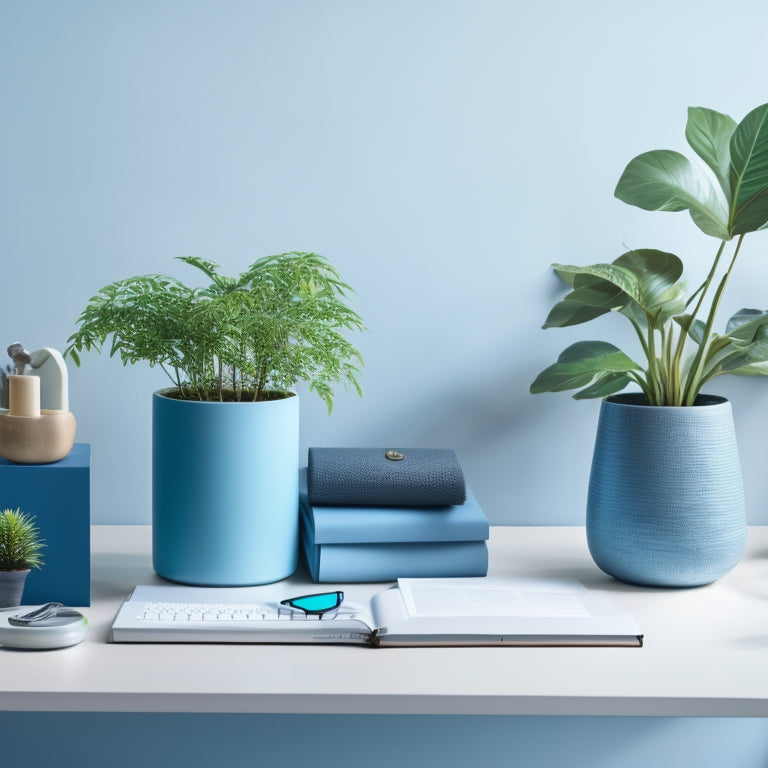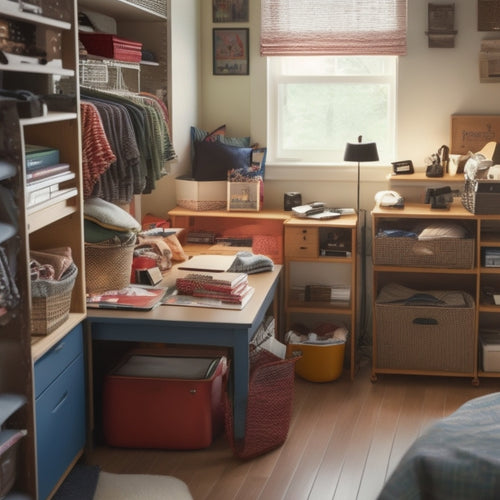
Revamp Your Life: Organize Time, Schedule, Belongings
Share
To revamp your life, start by mastering your daily routine, prioritizing tasks, and allocating sufficient time for each activity. Streamline your living space by decluttering, optimizing storage, and creating functional zones. Organize essential documents by implementing a document organization system, categorizing files, and storing important papers securely. Simplify family logistics by efficient meal planning, using a shared calendar, and establishing a consistent morning routine. Finally, achieve long-term preparedness by prioritizing emergency kits, storing batteries properly, and having a family documents cheat sheet. By tackling these key areas, you'll be well on your way to a more organized, productive, and stress-free life, and there's even more to discover.
Key Takeaways
• Streamline your daily routine by prioritizing tasks, focusing on critical ones during most productive hours, and delegating or deferring less pressing tasks.
• Optimize your living space by decluttering, rearranging furniture, and utilizing natural light to reduce stress and increase productivity.
• Implement a document organization system to categorize and store important papers, and consider digitalization or investing in storage solutions.
• Simplify family logistics by using a shared calendar, designating a 'launching pad' for belongings, and establishing a consistent morning routine.
• Achieve long-term preparedness by prioritizing emergency kits, storing batteries properly, and having a family documents cheat sheet for quick access.
Mastering Your Daily Routine
By streamlining your daily routine, you can reclaim lost time, reduce stress, and create a sense of control, ultimately paving the way for a more organized and productive life.
To achieve this, prioritize tasks by categorizing them into must-haves, should-haves, and nice-to-haves. Focus on completing the most critical tasks during your most productive hours, and delegate or defer less pressing ones.
Effective time management is key to mastering your daily routine. Set realistic goals, allocate sufficient time for each task, and leave buffers for unexpected interruptions. By doing so, you'll be able to tackle your to-do list with confidence, freeing up time for relaxation and enjoyment.
With a well-structured daily routine, you'll be amazed at how much more you can accomplish while maintaining a sense of calm and control.
Streamlining Your Living Space
Having mastered your daily routine, you can now focus on creating a harmonious living space that supports your newfound productivity by implementing organizational systems and strategies that cater to your unique needs and lifestyle.
To achieve this, consider the following:
-
Embrace decluttering strategies to free up space and reduce stress. Adopt a minimalist living approach to only surround yourself with what brings you joy or serves a purpose.
-
Optimize your space by rearranging furniture to create functional zones, making the most of natural light, and selecting multi-functional pieces.
-
Incorporate functional design elements, such as storage ottomans or desks with built-in shelving, to maximize storage and minimize clutter.
- Create a 'home' for each item, assigning a designated spot for everything to maintain order and make cleaning a breeze.
Organizing Essential Documents
One crucial aspect of achieving a sense of control and preparedness in life is organizing essential documents. This can help reduce stress, save time, and provide a sense of security in case of emergencies.
Implementing a document organization system can be a game-changer. Consider digitalization, where you scan and store important papers electronically, freeing up physical storage space. Alternatively, invest in storage solutions like fireproof safes or secure file cabinets to protect your valuable documents.
Create a categorized system, separating documents into folders or files, making it easy to locate specific papers when needed. By organizing your essential documents, you'll be better equipped to handle unexpected situations and enjoy a sense of calm, knowing your important papers are in order.
Simplifying Family Logistics
Efficiently managing family logistics requires a deliberate approach to organizing time, schedules, and belongings, enabling households to streamline daily routines and respond more effectively to unexpected events.
By implementing a few simple strategies, families can simplify their logistics and reduce stress. Here are a few key areas to focus on:
-
Efficient meal planning: Plan meals in advance to save time and money, and reduce food waste.
-
Coordinating family events: Use a shared calendar to keep track of schedules and appointments, and make sure everyone is on the same page.
-
Streamlining morning routines: Establish a consistent morning routine to get everyone out the door on time, and consider prep work the night before to make mornings even smoother.
- Designating a 'launching pad': Designate a spot near the front door as a 'launching pad' where everyone can place their belongings, making it easier to grab what you need on the way out.
Achieving Long-Term Preparedness
To guarantee long-term preparedness, families should prioritize organizing essential items, such as emergency car kits, batteries, and important documents, to mitigate the impact of unexpected events and minimize stress.
By having a well-stocked emergency car kit, you'll be ready for roadside emergencies. Properly storing batteries ensures you're prepared for power outages. A family documents cheat sheet provides quick access to important information.
When it comes to emergency planning, having survival skills and resource management in place is essential for crisis readiness. By taking these steps, you'll be better equipped to handle unexpected situations, reducing stress and anxiety.
Frequently Asked Questions
How Do I Prioritize Tasks When Everything Seems Urgent?
When everything seems urgent, how do you avoid feeling like a firefighting superhero?
To prioritize tasks effectively, try task categorization: separate tasks into must-haves, should-haves, and nice-to-haves.
Then, create a priority matrix to visualize and rank tasks based on their urgency and importance.
Can I Still Be Organized if I'm Not a Naturally Tidy Person?
Can you still be organized if you're not naturally tidy? Absolutely! Organization is a skill that can be developed through personal growth and habit formation.
It's about creating systems that work for you, not about being innately tidy. Focus on setting realistic goals, breaking tasks into manageable chunks, and celebrating small wins.
With time and practice, you'll develop organizational habits that become second nature, even if you're not naturally inclined towards tidiness.
How Often Should I Review and Update My Emergency Kit?
While it's tempting to assume an emergency kit is a one-and-done task, the reality is that expiration dates and seasonal needs can render your kit ineffective.
To avoid this, schedule a bi-annual review to confirm medications, batteries, and food supplies are still viable.
Incorporate seasonal refreshments, such as sunscreen in summer or warm blankets in winter, to keep your kit relevant and effective.
Are There Specific Types of Batteries I Should Stockpile?
When stockpiling batteries for emergency preparedness, it's important to take into account battery expiration dates to make sure they remain functional during power outages.
Focus on storing high-quality, long-life batteries with a long shelf life, such as lithium or nickel-metal hydride batteries.
Avoid mixing old and new batteries, as this can reduce overall performance.
Rotate your stock every 2-3 years to maintain a fresh supply.
Can I Customize My Emergency Kit for Different Family Members?
When it comes to customizing your emergency kit for different family members, kit personalization is key. Consider the age and specific needs of each individual, such as infants, seniors, or those with disabilities.
Tailor the kit's contents to address their unique requirements, like diapers, medications, or communication devices. By doing so, you'll guarantee each family member has the essential items they need in case of an emergency.
Related Posts
-

Why Double Rods Are Key to Small Closet Organization
By installing double rods, you can instantly double your storage capacity and open up a more organized, clutter-free ...
-

Why College Students Need Smart Storage Systems
As you navigate the challenges of college life, you'll quickly realize that a smart storage system is essential to tr...
-

Streamline Your Space: Decluttering Strategies for Minimalists
You're wasting time and energy maneuvering through cluttered spaces, which is why streamlining your space is essentia...


